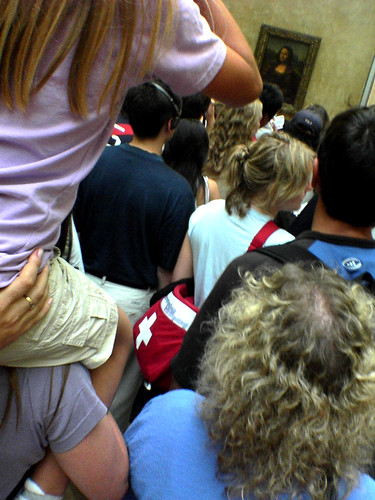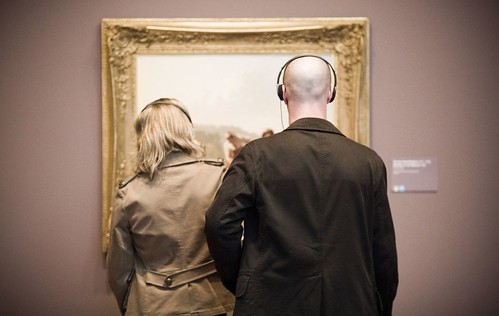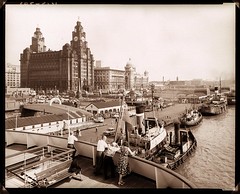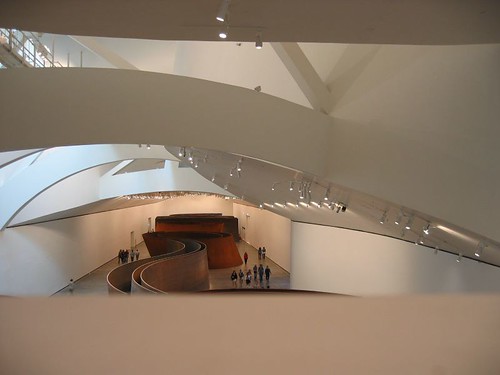E-learning Systems for Aged Art Museums
Published by themusediffuse on Thursday, August 10, 2006 at 3:05 PM.

Who said internet and e-learning systems are necessary for museums of only Contemporary Art? See in the photo at the left (if you are able) La Gioconda at the
The Louvre offers virtual visits on its website, but the one devoted to La Gioconda is even more frustrating than on site. Although the extremely famous painting appears without visitors, the software does not allow getting closer to the art work.
Despite this fact, what is probably the most visited museum on the World only offers traditional information systems. In addition to the text and the images on the website (with very good quality,) the only supplementary information option to visitors are audio guides. After having to queue during long time and on receipt of 5 euros and an ID deposit, visitors will be allowed to carry an uncomfortable portable cd player model during their visit. The other option is hiring a guide tour, which because of the amount of visitors, the noise and the real movement difficulty; includes a headset service to be able to hear guides’ explanations.
Maybe the logical alternative to this entire nuisance would be an additional podcast and/or vodcast service on the website of the museum, so people would arrive to the museum provided with their respective explanations to enjoy at the same time they appreciate art works or, who knows, in the meanwhile they queue plugged to some music device customized with the very Gioconda herself.
Images: Corneille, Petite: Mona Lisa, 2005. Photography. (up.) iPod® Nano Skin ‘Mona Lisa’ (left)
Labels: e-artcasting, Sociable
Sistemas de aprendizaje electrónico a distancia para museos de arte entrados en años
Published by themusediffuse on at 11:58 AM.
El Louvre ofrece visitas virtuales en su página web, pero la dedicada a La Gioconda es, si cabe, más frustrante que al natural. Aunque en la imagen virtual la celebérrima pintura aparece sin público, el programa informático no permite acercarse a la obra. Pese a ello, el que es probablemente el museo de arte más visitado del mundo sólo ofrece los sistemas de información tradicionales. Además de el texto y las imágenes de la página web (de muy buena calidad), la única alternativa de información adicional para el visitante son las audioguías. Tras esperar una larga cola y previo pago de 5 euros y depósito de un documento de indetinficación, el visitante podrá cargar con un incómodo modelo de lector portátil de cd durante visita. La otra opción es contratar un servicio de guía que, eso sí, dada la afluencia de público, el ruido y la dificultad real de movimiento, incluye un servicio de auriculares para poder oir sus explicaciones.Tal vez la alternativa lógica a todo este engorro sería un servicio adicional de podcasts y/o vodcasts en la página web del museo, así los visitantes ya podrían llegar provistos de sus correspondientes explicaciones que poder disfrutar al mismo tiempo que aprecian las obras o, quien sabe, mientras hacen cola enchufados a un aparato personalizado por la mismísima Gioconda.
Imágenes (véanse en la versión en inglés de este mismo artículo): Corneille, Petite: Mona Lisa, 2005. Fotografía. (izquierda) iPod® Nano Skin ‘Mona Lisa’ (derecha)
Podcasting and eternal topics
Published by themusediffuse on Tuesday, August 08, 2006 at 4:51 PM.

Couple at De Young Museum of San Francisco (USA) using the audioguides-podcast service the museum offers. A cutting-edge image that however, closely relates the deepest tradition of American Art: see the similarities with the very famous Grant Wood's painting American Gothic.
More information about De Young Museum podcasts at our Wikispace.
Images : Hawk, Thomas: Couple, 2006. Photography (left); Wood, Grant: American Gothic, 1930. Oil on beaverboard, 74.3 x 62.4 cm. Col. Art Institute of Chicago (right)
Pareja en el Museo De Young de San Francisco (USA) utilizando el servicio de audioguías-podcast que el museo ofrece. Una imagen vanguardista que, sin embargo, alude directamente a la tradición más profunda del arte estadounidense: obsérvese el parecido con la famosísima pintura de Grant Wood, American Gothic.
Más información sobre los podcasts del Museo De Young en nuestro Espacio Wiki.
Imágenes (véanse en la versión en inglés de este mismo artículo): Hawk, Thomas: Couple, 2006. Fotografía (izquierda) Wood, Grant: American Gothic, 1930. Óleo sobre tabla, 74.3 x 62.4 cm. Col. Art Institute de Chicago (derecha)
National Museums Liverpool’s 'Web 2.0' Photocasting Project
Published by themusediffuse on Monday, July 31, 2006 at 4:57 PM.

A wonderful example of how 'Web 2.0' (a new generation of web services that make use of collaboration, sharing and tagging to create 'social software') can engage new audiences to Art Museums as well as their collections can be revisited by contemporary visions.
National Museums Liverpool recently organized a photocasting project for documenting Liverpool, which has been called “Stewart Bale 2.0". This project is currently an online photographic exhibition and it is based on the collection of photographs by Stewart Bale Ltd. that National Museums Liverpool holds. The organization invited both amateur and professional photographers who use the web service Flickr to recreate the photographs of the mentioned collection.
Images: Stewart Bale: Pier Head, 1959 (original) (left); Pete Carr: Photography of Pier Head, 2006 (right)
Proyecto de Photocasting 'Web 2.0' de National Museums Liverpool
Published by themusediffuse on at 4:17 PM.National Museums Liverpool (Reino Unido) ha organizado recientemente un proyecto de photocasting para documentar Liverpool, que ha sido llamado “Stewart Bale 2.0”. Este proyecto es en la actualidad una exposición de fotografía en internet y está basado en la colección de fotografías de Stewart Bale Ltd. que National Museums Liverpool posee. La organización invitó a fotógrafos, tanto aficionados como profesionales que utilizan el servicio the internet Flickr, a recrear las fotografías de la mencionada colección.
Imágenes (véanse en la versión en inglés de este mismo artículo): Stewart Bale: Muelle Head, 1959 (original) (izquierda); Pete Carr: Fotografía del Muelle Head, 2006 (derecha)
Fotos prohibidas en Museos de Arte
Published by themusediffuse on Sunday, July 30, 2006 at 6:52 PM.Me pregunto por qué los visitantes pueden sacar fotos y grabar con sus propias videocámaras en algunos museos y en otros no. Un ejemplo de ello sucede en el Museo Guggenheim de Nueva York. Grabar está permitido solamente desde la planta baja pero no desde las superiores. No obstante, cualquiera facilmente verá a gente grabando a lo largo de toda la rampa con toda clase de aparatos (no sólo teléfonos móviles) ¿Por qué algunos museos son tan reacios a abrazar y adaptarse a las necesidades del visitante y el profesional actual? ¿Cómo se valora entonces la interacción del público?
Esta foto (véase artículo anterior) ha sido sacada en el Museo Guggenheim de Bilbao (España) Fue tomada furtivamente y pertenece a un grupo llamado “Fotos Prohibidas” que saca fotos en lugares donde no está permitido. ¿Deben ser los museos de arte esa clase de lugares?
Forbidden Photos inside Art Museums
Published by themusediffuse on Friday, July 28, 2006 at 11:09 PM.
I wonder why visitors can take photos and record with their own video cameras in some museums but not in others. An example of this happens at the Guggenheim Museum of New York. Recording is only allowed from its main level but not from the upper ones. However, anyone will easily see people shooting from all along the ramp with all kind of specific devices (not only cell phones.) Why some museums are so reluctant to embrace and adapt themselves to the needs of current visitors and professionals? How is then the public’s interaction valued?
This photo was taken inside the Guggenheim Museum of Bilbao (Spain). It was obtained furtively and belongs to a group called Fotos Prohibidas (Forbidden Photos) that takes photos in places where it is not allowed. Shoud be Art Museums that kind of places?
Casting in Art Museums es una investigación sin ánimo de lucro, una fuente de información y una red de contactos profesionales hecha para compartir experiencias, intercambiar información y desarrollar recursos relacionados con Photocasting, Podcasting y Vodcasting en Museos de Arte de todo el mundo. Es un lugar de referencia tanto para profesionales y amantes de los museos, como para entusiastas de los castings. Te animamos a unirte a nuestra comunidad, a utilizar nuestros recursos y a enriquecer este espacio con tu participación.
Además de este Blog, el projecto en general se compone de un Espacio Wiki, un Proyecto de Photocasting y una lista de Referencias.
- Casting in Art Museums Wiki es un espacio Wiki de trabajo en curso para consultar y añadir las mejoras que Museos de Arte están llevando a cabo en relación a Photocasting, Podcasting y Vodcasting. Te animamos a que consultes la lista de museos y añadas y actualices la información.
- Casting in Art Museums Photocasting Project es un espacio Flickr de trabajo en curso para aglutinar las experiencias de los visitantes de Museos de Arte. Intentamos reunir tu visión específica the ellos además de tus anécdotas visuales y curiosidades.
- Casting in Art Museums References es un espacio Del.icio.us de trabajo en curso donde consultar, compartir y contribuir a nuestras páginas web de referencia y casts.
Como puedes ver, además de leer y publicar en este Blog también puedes disfrutar de un amplio abanico de recursos complementarios. Ten en cuenta que en la actualidad continuamos trabajando en el desarrollo de este espacio, así que problablemente detectarás algunas mejoras que se deberían hacer. Por favor, no dudes en hacer cualquier sugerencia al respecto: estaremos encantados de recibir tus impresiones.
El idioma es otro tema importante de nuestro projecto. Este Blog es en Español y en Inglés, así que puedes utilizar cualquiera de los dos idiomas para tus aportaciones. No obstante, agradeceríamos muchísimo traducciones de tus textos originales y/o que colaboraras con nosotros traduciendo los comentarios de otros, adjuntándolos al texto original en forma de comentario.
Finalmente, un recordatorio: no olvides añadir y actulizar en el Wiki la información sobre tu Museo de Arte o tus castings favoritos en ellos.
¡Estamos deseando tu participación!
Ponte en contacto con nosotros en themusediffuse@gmail.com escribiendo en la casilla “Asunto” la etiqueta [castinginartmuseums]
Casting in Art Museums is a non-profit research project, an information source and a professional network to share experiences, exchange information and develop resources about Photocasting, Podcasting and Vodcasting and in Art Museums from all over the world. This is a reference place not only for professionals and lovers of art museums but also for enthusiasts of castings. We encourage you to join our community, use our resources and enrich this site with your participation.
In addition to this Blog, the project in general is composed of a Wikispace, a Photocasting Project and a list of References
- Casting in Art Museums Wiki is a work in progress Wiki Site to check and add the improvements that Art Museums are addressing in terms of Photocasting, Podcasting, and Vodcasting. We encourage you to check the list of museums and add and update the information.
- Casting in Art Museums Photocasting Project is a work in progress Flickr Site to gather visitors’ experiences in Art Museums. We try to collect your particular vision of them in addition to your visual anecdotes and curiosities.
- Casting in Art Museums References is a work in progress Del.icio.us Site where checking, sharing and contributing to our recommended websites and casts.
As you can see, apart from reading and posting on this Blog, you can also enjoy a wide range of complementary resources. Note that we are currently working on the development of this site, so maybe you will notice some upgrades that should be done. Please, do not hesitate to make suggestions about them: we will be happy to receive your feedback.
Language is an important issue of this project. This Blog is in English and in Spanish, so you can use any of both languages to make your contributions. However, we would really appreciate you to add also a translation to your original text and/or to collaborate with us translating other’s comments, attaching your translations as comments to the originals.
Finally, a reminder: do not forget to add and update in the Wiki the information about your Art Museum or your favorite castings in them.
We are looking forward your contributions!
Contact us in themusediffuse@gmail.com writing in the “subject” box the tag [castinginartmuseums]



